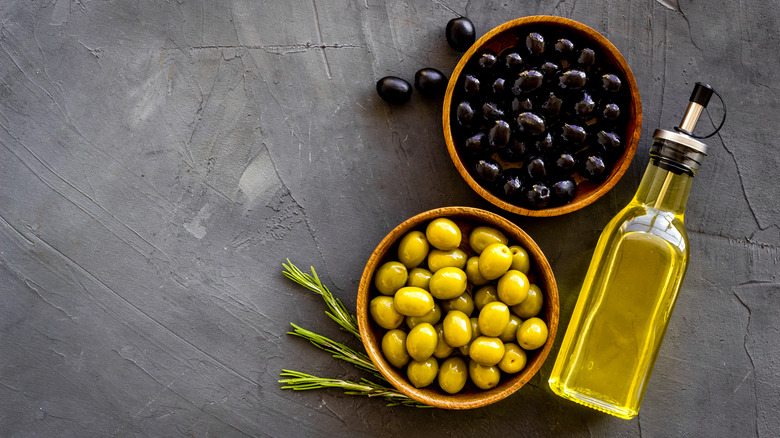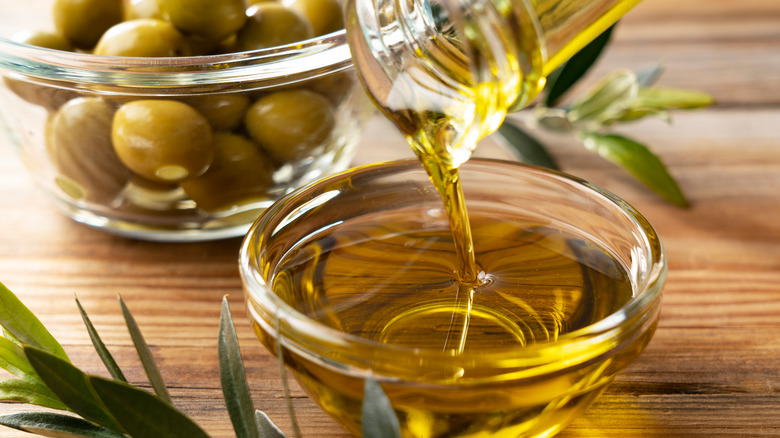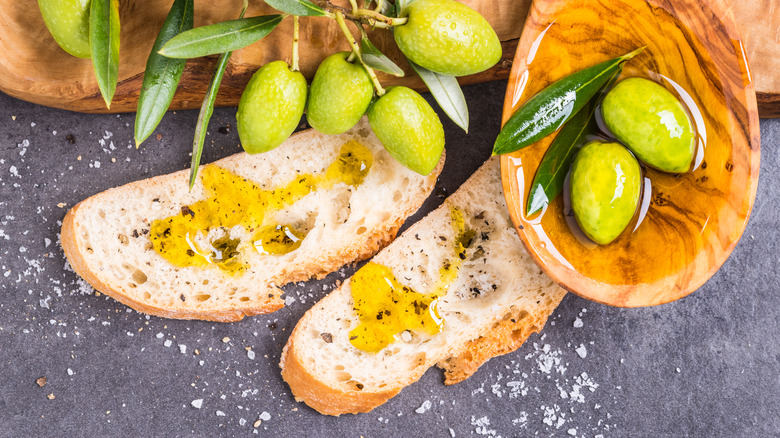Yellow Vs. Green Olive Oil: What's The Difference?
Correction 2/8/23: An earlier version of this story stated that light-tasting olive oil may be mixed with canola oil. "Light" refers to olive oil's color and flavor, not dilution with other types of oil.
Based on its taste, quality, and various health benefits, olive oil is pure liquid gold. No, really — Homer, one of the most influential poets and authors of all time, pronounced olive oil authentic liquified gold in the 8th century, per the Italian Department of Agricultural and Environmental Science. But before Homer, there were Hippocrates and Galen, who praised olive oil centuries prior for its beautifying capabilities and medicinal qualities (per Torres & Ribelles). According to the North American Olive Oil Association, olive oil was also used for aches, pains, and digestive health and applied topically to replenish dry or cracked skin.
While it can still be used for these same properties today, olive oil is mostly known for its rich, complex taste of fruity or nutty flavors with spicy notes. Olive oil is also a healthier alternative with the help of oleic and monounsaturated fatty acids, as reported by the American Heart Association. Compared to unhealthy or adverse fats, these acids can supply nutrients and antioxidants throughout the body and positively boost vital organs, such as the heart and brain.
But choosing the right one can be a daunting task. Each comes with a different color, flavor profile, and smoking point, but all are labeled elusively and masked in a dark green bottle. Yellow, green, cold-pressed, extra-virgin, pure, refined — what's the difference? Does it even matter? It turns out there are quite a few distinctions, and they can make or break your cooking regime.
Does it matter what color olive oil you use?
Pompeian notes that olive oil can come in many colors, including green, yellow, and gold, based on the original olive it was made from and its natural environment. Olive Oil Source adds that color does not represent the olive oil's taste; this depends on the type of olive used (green or purple) and how mature it was at harvest. However, it can sometimes represent the amount of mechanical interference when crafting it. Light-tasting olive oils and light-tasting extra-virgin olive oils (EVOO) are often more refined to achieve a neutral flavor and high smoke point, per MasterClass. This makes them perfect for frying and baking.
Varying oils have different smoke points, or temperatures to which they can be cooked, per the USDA. Serious Eats explains that smoke points are vital to adhere to in the kitchen. For example, if you used a robust EVOO to fry or sear food at a high temperature, the fats inside the oil could deconstruct. In this scenario, these fats would then begin smoking and, if left unchecked, could possibly reach their flash point. This can, in some cases, create a vaporized, flammable gas that can be dangerous. (For the record, some publications like Bon Appetit warn against using EVOOs for cooking methods like deep-frying, while others like U.S. News opine that the hubbub over EVOO smoke points has been exaggerated over the last few years.) Keeping this in mind, one option is to keep robust EVOO in your kitchen for things like drizzling, dipping, and dunking, and to use lighter oils for frying.
When to use specific olive oils
The Farmer's Almanac notes that olive oil can be ranked based on its oleic and fatty acid content. The higher the acids, the lower the oil is on the scale. However, it's important to remember that these classifications only represent the amount of processing used to craft the oil.
EVOO is superior — think cold-pressed or unrefined olive oils that do not utilize heat during extraction. They can be used for dipping bread or for sautéing. Virgin olive oils are still relatively unprocessed, except there are higher amounts of oleic acids inside the oil, the Farmer's Almanac notes. They can be used as a dressing similar to EVOO. Then, there's pure olive oil, which has been processed and contains more fatty acids. Refined olive oils should be used when baking or roasting. Light-tasting olive oils fall to the bottom of the scale because they are not technically "pure." Instead, these are the most processed and contain a mixture of refined and virgin oils. They can be distinguished by their light color and are best for frying, per the Farmer's Almanac.
MasterClass explains that because EVOO is the least refined, it's often the priciest of the bunch. It also has more olive-based notes that can appear somewhat spicy. And because it does not undergo multiple pressings or heat treatments, it may obtain a greener hue. However, the color still mostly depends on the type of olive used when pressed and other natural factors.


